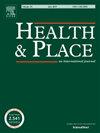The “uneven road” to food: Socioeconomic disparities in the mobility burden of food purchasing behavior in major US cities, 2019–2023
IF 4.1
2区 医学
Q1 PUBLIC, ENVIRONMENTAL & OCCUPATIONAL HEALTH
引用次数: 0
Abstract
Socioeconomic factors contribute to distinct patterns of food-purchasing behaviors, placing a higher burden of mobility on vulnerable, deprived populations. Traditional approaches often overlook the dynamics of human activity as contextual influences, simulating a perceived food environment that contradicts the actual use thereof. The rise of large-scale mobile phone data presents a unique opportunity to capture real behavioral patterns and their mobility implications at a fine-grained level. Using a Time-Weighted Kernel Density Estimation (TWKDE) model on mobile phone data, this study introduces two novel measures - the Spatial Engel’s Coefficient (SEC) index and the Distance-to-Activity Curve (DAC) – to assess the equity of food-purchasing travel across nine U.S. cities over five years, analyzed by socioeconomic status, time period, and location. Our findings reveal that lower socioeconomic status is strongly associated with greater mobility burdens in food-purchasing travel. This mobility gap between the highest and lowest socioeconomic groups was further exacerbated during the COVID-19 pandemic, manifesting in the form of spatial segregation of opportunities within cities. This paper contributes to the literature by developing novel activity-based tools that offer a more nuanced understanding of the behavioral characteristics of food-purchasing activities. These empirical insights can help policymakers identify the communities facing the greatest mobility burdens and guide targeted, place-based interventions to promote equity in food access.
通往美食的 "不平坦之路":2019-2023年美国主要城市食品购买行为的流动性负担的社会经济差异。
社会经济因素促成了不同的食品购买行为模式,给弱势和贫困人口带来了更大的流动性负担。传统的方法往往忽视了人类活动作为环境影响的动态,模拟了与实际使用相矛盾的感知食物环境。大规模移动电话数据的兴起提供了一个独特的机会,可以在细粒度的水平上捕捉真实的行为模式及其移动性含义。利用手机数据的时间加权核密度估计(TWKDE)模型,本研究引入了两种新的测量方法——空间恩格尔系数(SEC)指数和距离-活动曲线(DAC)——来评估美国九个城市在五年内食品购买旅行的公平,并根据社会经济地位、时间段和地点进行了分析。我们的研究结果表明,较低的社会经济地位与食品购买旅行中较大的流动性负担密切相关。在2019冠状病毒病大流行期间,最高和最低社会经济群体之间的这种流动性差距进一步加剧,表现为城市内部机会的空间隔离。本文通过开发新颖的基于活动的工具,对食品购买活动的行为特征有了更细致的理解,从而为文献做出了贡献。这些经验见解可以帮助决策者确定面临最大流动性负担的社区,并指导有针对性的、基于地方的干预措施,以促进粮食获取的公平性。
本文章由计算机程序翻译,如有差异,请以英文原文为准。
求助全文
约1分钟内获得全文
求助全文
来源期刊

Health & Place
PUBLIC, ENVIRONMENTAL & OCCUPATIONAL HEALTH-
CiteScore
7.70
自引率
6.20%
发文量
176
审稿时长
29 days
期刊介绍:
he journal is an interdisciplinary journal dedicated to the study of all aspects of health and health care in which place or location matters.
 求助内容:
求助内容: 应助结果提醒方式:
应助结果提醒方式:


